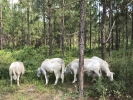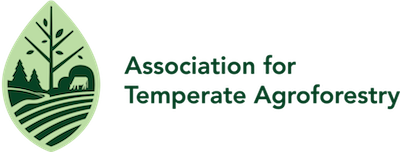| |
Hello Visitor,
Welcome to the March 2019 version of the Temperate Agroforester. The newsletter welcomes contributions for future issues and input or feedback about anything that you read in this issue.
Uma Karki, Christine C. Nieman, Steve Gabriel, Diomy Zamora and Callie Maron, Editors - Temperate Agroforester
Events
2019. 16th North American Agroforestry Conference. Willamette Valley, Corvallis, Oregon.

Call to Action
AFTA needs you! We need your research updates, blog posts, news items and other information to inform our followers. Contact: Andres Anchondo. We are also looking for volunteers to help with membership engagement and website content. Volunteer today to help keep AFTA moving foward.
Membership
Are you a member of AFTA? If not consider joining by clicking here. Your membership gives you access to the members-only area, discounts on conference registration, and helps support AFTA's mission to promote agroforestry.
Contents
Shailes Bhattrai1, Uma Karki1, Sanjok Poudel2, and Lila B. Karki1 1Tuskegee University, 2Virginia Polytechnic Institute and State University Corresponding author’s email: sbhattrai5555@tuskegee.edu
 Non-industrial private landowners hold 87% of the total woodland coverage (69%; 23 million acres) in Alabama. Woodlands have been primarily used for timber production (generated US$ 21 billion annual revenue) (AFC no date) and their potential use for managed grazing is largely ignored. Woodland grazing can significantly support animal production, especially for small farmers, who do not have enough pasture acreage to meet the forage requirements for their animals. A majority of small farmers hold woodlands, but they are not managing them for sustainable grazing.
Read More
Gabriel Pent, Adam Downing, and John Fike, Virginia Tech
 The removal of livestock from a pasture during the tree establishment phase may not be a requirement for the successful integration of trees into a pasture. While a multitude of factors influence tree survival, field-trial research projects at Virginia Tech’s Shenandoah Valley Agricultural Research and Extension Center suggests that newly-planted trees can be protected from livestock that would otherwise destroy them.
A demonstration silvopasture project on this farm aims to show how a degraded hardwood stand on a medium quality site might be converted into a mixed-use forage, livestock and timber-producing system. In this case, the silvopasture was developed by thinning an unmanaged timber stand full of invasive species (primarily bush honeysuckle (Lonicera spp.)). Green ash (Fraxinus pennsylvanica) was the dominant tree species in the stand. Unfortunately, the emerald ash borer found and decimated these trees, and they had to be removed, leaving the resulting silvopasture with too few trees.
Read More
Mario M. Yanez, Inhabit Earth
 Inhabit Earth’s (http://inhabit.earth) mission is global climate stabilization. There is emerging research that indicates that most agroforestry systems perform better than natural forests in sequestering carbon. This is well documented in seminal works such as The Carbon Farming Solution and Project Drawdown.
We have been applying innovative approaches that leverage urban forests to address complex ecosocial challenges and begin to stabilize climate. The innovation lies in integrating and extending various fields of practice, such as agroforestry, regional planning, urban agriculture, landscape architecture, permaculture, and economic development.
Read More
Jonathan Bates, Food Forest Farm, Jonathan@FoodForestFarm.com
 Silvopasture, the intentional combination of trees, forage plants, and livestock together as an integrated, intensively-managed system, is an agroforestry practice improving landscapes throughout the world. There is a form of silvopasture, called intensive silvopasture, which has been experiencing rapid growth in tropical climates since its Australian beginnings in the 1970s (Cardona et al. 2014). Intensive silvopasture is the combination of healthy pastures with as many as 4000 nitrogen-fixing trees planted per acre. The trees are grazed along with the pasture, and livestock are rotated out of the paddock to let the trees and pasture recover. Although this system is proving itself a catalyst for significantly increasing food yields, and biological diversity in the tropics (Cardona et al. 2014), there are few temperate climate examples.
Read More
Jacob Grace, Outreach Coordinator, Savanna Institute
 The Savanna Institute hosted its 6th Perennial Farm Gathering (PFG) on December 7th and 8th in Madison, Wisconsin. This annual event brings together agroforestry producers, researchers, specialists, and enthusiasts for two days of networking, knowledge-sharing, and festivities.
Read More
|
|






